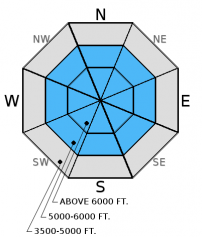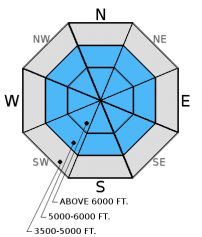| Tuesday | Tuesday Night | Wednesday | |
|---|---|---|---|
| Cloud Cover: | High pressure building | Weak disturbance enters our area | Warming with light precipitation |
| Temperatures: | 30-38 deg. F. | 26-32 deg. F. | 33-42 deg. F. |
| Wind Direction: | W-SW | W-SW | W-SW |
| Wind Speed: | 9-12 gusts 28 | 10-14 gusts 31 | 9-13 gusts 28 |
| Snowfall: | 0 in. | 0-1 in. | 0-1 in. |
| Snow Line: |
Whitefish Range
Swan Range
Flathead Range and Glacier National Park
How to read the forecast
Human triggered and natural avalanches were reported Saturday and Sunday. Natural activity continues to decrease but human triggered avalanches are still likely. Our current snowpack is widely variable and backcountry travel is tricky and dangerous. The avalanche danger is CONSIDERABLE above 5000 feet and MODERATE below 5000 feet. Careful snowpack evaluation, cautious route-finding, and conservative decision making are essential. For more information on the recent avalanche fatality please visit our observations page (observation).

3. Considerable
?
Above 6500 ft.
3. Considerable
?
5000-6500 ft.
2. Moderate
?
3500-5000 ft.
- 1. Low
- 2. Moderate
- 3. Considerable
- 4. High
- 5. Extreme
-
Type ?
-
Aspect/Elevation ?

-
Likelihood ?CertainVery LikelyLikelyPossible
 Unlikely
Unlikely -
Size ?HistoricVery LargeLargeSmall

The combination of recent new snow and moderate to strong wind gusts has formed fresh wind slabs at mid and upper elevations. Predominate southwest flow has top loaded north through east aspects and cross-loaded northwest and southeast aspects. Wind slabs that formed on smooth crusts may take longer to strengthen. Additionally, wind drifted snow adds weight to the snowpack just like new snow, and can stress existing weak layers that may fail deeper and propagate wider. Look for smooth, rounded features on the snow surface or deeper looking pillows. Carefully evaluate recently wind loaded terrain before committing to a slope.
-
Type ?
-
Aspect/Elevation ?

-
Likelihood ?CertainVery LikelyLikelyPossible
 Unlikely
Unlikely -
Size ?HistoricVery LargeLargeSmall

Unfortunately, we are currently stuck with this DIFFICULT problem in our snowpack. There is a lot of variability across the advisory area with this problem that warrants careful snowpack evaluation and cautious route-finding. Buried surface hoar and weak faceted snow exist in all ranges, but you won't find them on all slopes and they vary in reactivity. Weak snow beneath the January 12 rain crust was the failure layer in the fatal avalanche on Saturday. It is taking more force to get this layer to fail, and in some locations we are seeing no results on this layer, but obviously it is still a layer of concern. The January 17 rain crust continues to be reactive in stability tests. This layer is potentially the culprit of several recent natural avalanches. Where this crust does not exist there is likely a density change in the snowpack that has been reactive in stability tests. These weak layers are now 2 to 4.5 feet deep after the recent series of storms. The obvious signs of instability have mostly diminished, but that does not imply stability. Given the tricky distribution of these persistent slabs it would be wise to avoid steep, open slopes and convexities. The only way to know if these layers are reactive is to dig into the snow and perform stability tests.
-
Type ?
-
Aspect/Elevation ?

-
Likelihood ?CertainVery LikelyLikelyPossible
 Unlikely
Unlikely -
Size ?HistoricVery LargeLargeSmall

Warm wet weather Saturday night/Sunday morning resulted in new snowfall with slab like characteristics. At low and mid elevations this snow was deposited on a rain crust formed Friday. A skier triggered avalanche occurred at this new snow/crust interface in Glacier Park Sunday. Also on Sunday, natural and human triggered avalanche activity was reported at this interface on southerly aspects east of the WMR ski area. At upper elevations the new snow fell on less dense snow creating an upside down snow surface. This interface was probably the failure layer in the natural avalanches in the Skook Chutes area Saturday along with a natural avalanche on a northerly aspect in Canyon Creek that was reported Sunday morning. The natural activity related to the storm slab is winding down but human triggered slides remain possible today. Pay attention to these unsettled slabs particularly when traveling in and around terrain traps. Remember that a small slide can affect deeper weak layers and potentially step down triggering a more dangerous avalanche. Obvious signs of a reactive surface slab are shooting cracks and whumphing.
There have been 10 avalanche fatalities in the United States since January 16, including one in the Whitefish Range in our advisory area on Saturday. This is not good, and our thoughts are with all of those involved. We have a tricky and dangerous snowpack in our area right now! We've seen recent, small natural and small to medium sized human triggered avalanches over the past 3 days. Now is not the time to push it into steep terrain, and also be aware of terrain traps below steep slopes. Choose low angled slopes and carefully evaluate the snowpack at any time. With deeper instabilities, the only way to know if the layer exists is to dig into the snow, and sometimes stability tests don't even work. This is the reason choosing conservative terrain (slopes less than 33 degrees) for a while is absolutely essential.
For more information on the recent avalanche fatality please visit our observations page (observation).
Sunday, experienced skiers in the southern Whitefish Range reported a natural avalanche on a northerly aspect in Canyon Creek at an upper elevation. They also reported remotely triggering the Half Moon slide path, east of the ski area, from 80-100 feet above the starting zone. The same party noted mid elevation natural avalanche activity in this same area. The failure layer appears to have been the storm slab deposited Saturday night/Sunday morning. Crown depths were reported to be in the 8-10 inch range.
Sunday, Ted Steiner (BNSF Avalanche Safety) and I traveled to Swede Creek in the northern Whitefish Range. Above 6000 feet we found 8-10 inches of new snow that exhibited slab like characteristics along with recently cross loaded southeasterly aspects. The January 17 crust was not present in this area but stability tests produced fracturing and propagation with moderate force that resulted in quality 1 shears at a density change possibly related to the January 17 event. With hard force we were able to get the weak snow below the January 12 rain crust to fracture and propagate with a quality 1- shear.
Also on Sunday a party of climbers/skiers in the Snyder Lake area of Glacier National Park triggered a 6 inch thick soft slab that slid on top of the rain crust that formed Saturday. The slide was 50-100 feet wide and 1 member of the group was carried 100 feet but did not sustain injuries. They also reported sluffing of the new snow and shooting cracks.
Saturday, the groomer for the Canyon Creek snowmobile trails reported several slab avalanches that occurred late afternoon in the Skook Chutes/Fiberglass Hill area of the Southern Whitefish Range. 2 of these reached the Canyon Creek snowmobile trail with one depositing debris 10 feet deep covering 30 feet of the trail.
A pilot flying over the area Saturday reported a large avalanche that likely occurred Friday on a south facing slope near McGinnis Creek in the southern Whitefish Range.
On Saturday, Erich was instructing a level 1 class in the southern Whitefish Range. They observed 4 recent avalanches in Canyon Creek (2 of them size D-2 and 2 were D 1-1.5) also thought to have slid on Friday. They noted variable results in stability tests on east, south, and west aspects. With hard force the January 17 crust fractured and propagated. They also were able to get the January 12 crust to fracture with hard force in compression tests. They noted clean, quality 1 shears on this layer. No other obvious signs of instability were observed. Guy and I were in the Wahoo drainage in the Flathead Range and found a new breakable crust on the surface. The January 17 rain crust was not present in this location (observation).
Two separate parties of skiers were the Dickey drainage and Essex Mountain both in the Flathead Range. They also found a breakable crust 1-2 inches thick on the surface up to 6000 feet. They did not observe any obvious signs of instability. Skiers on Hellroaring peak in the southern Whitefish Range did not observe a surface crust, but found a firm, wind affected surface.
Friday, BNSF Avalanche Safety reported several natural avalanches in their program area. Visibility was limited, but the avalanches appeared to be loose, wet.
We were in the Red Meadow area in the northern Whitefish Range on Friday. Warm temperatures at low to mid elevations began to moisten the snow surface early in the day. We noted roller balls, tree bombs, and small, loose, wet avalanches in these elevation bands. Below 6000 feet the warm temperatures formed a more cohesive recent storm layer that slid on the January 17 rain crust along steep gully walls while skiing out (Photo). We found the January 12 and January 17th rain crusts that were buried 1-2 feet deep with weak, faceted snow forming around them.
Visit our Observations page and our You Tube channel for more observations from the entire season.
Thanks to everyone for submitting observations. They are extremely useful and could help save lives.
HOW TO SUBMIT OBSERVATIONS:
Email: [email protected]
Call and leave a message: 406.387.3821
You can also submit quick observations via text: 406.241.4571 (FAC mobile)
OR
Submit Snowpack Observations: http://www.flatheadavalanche.org/node/add/snowobs
Submit Avalanche Observations: http://www.flatheadavalanche.org/node/add/avyobs
Temperatures were seasonal and no new snow fell in the past 24 hours. Winds were light out of the west and southwest with moderate to strong gusts up to 28 mph. Currently, temperatures above 6000 feet range from 19º-26º F and winds are west-southwest at 2-12 mph with gusts from 5-23 mph. For today, expect high pressure to continue to strengthen across our area. Temperatures will rise to the upper 20s - mid 30s, and winds will move out of the west and southwest at 5-15 mph with moderate to strong ridge top gusts up to 36 mph.
| 0600 temperature: | 18-26 deg. F. |
| Max. temperature in the last 24 hours: | 21-28 deg. F. |
| Average wind direction during the last 24 hours: | WSW |
| Average wind speed during the last 24 hours: | 5-15 mph |
| Maximum wind gust in the last 24 hours: | 10-28 mph |
| New snowfall in the last 24 hours: | 0 inches |
| Total snow depth: | 61-89 inches |
This advisory applies only to backcountry areas outside established ski area boundaries. This advisory describes general avalanche conditions and local variations always occur. This advisory expires at midnight on the posted day unless otherwise noted. The information in this advisory is provided by the USDA Forest Service who is solely responsible for its content.









































